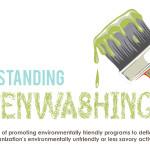
How to make sure your “all natural” products are the real deal
From electric cars to reusable shopping bags, it’s undeniable that “going green” is one of the fastest growing trends out there today. This is great news for the eco-friendly consumer, as companies are scrambling to offer greener versions of their products to meet demand.
Unfortunately, many companies have also noticed that it’s much cheaper to claim to have environmental, health or safety standards than it is to actually live by them. When a company misleads its customers about the safety or environmental impact of its products or practices, it’s called greenwashing.
Many people are aware of the high profile instances (BP after the oil spill, anyone?), but the practice isn’t limited to corporate makeovers. Greenwashing occurs from national ad campaigns down to labels on the products you buy everyday.
In a 2010 study, TerraChoice investigated the claims of 4,744 “green” products carried in stores across the U.S. and Canada, finding that more than 95 percent of these products were guilty of at least one of what they call:
The Seven Sins of Greenwashing
1. Hidden Trade-Off: Labeling a product as environmentally friendly based on a small set of attributes (i.e., made of recycled content) when other attributes not addressed (i.e., energy use of manufacturing, gas emissions, etc.) might make a bigger impact on the eco-friendliness of a product as a whole.
2. No Proof: Making an environmental claim without providing easily accessible evidence on either the label or the product website (i.e., a light bulb is touted as energy efficient with no supporting data).
3. Vagueness: Using terms that are too broad or poorly defined to be properly understood (i.e., an “all-natural” cleaner may still contain harmful ingredients that are naturally occurring).
4. Irrelevance: Stating something that is technically true but not a distinguishing factor when looking for eco-friendly products (i.e., advertised as “CFC-Free”—but since CFCs are banned by law this is unremarkable).
5. Lesser of Two Evils: Claiming to be greener than other products in its category when the category as a whole may be environmentally unfriendly (i.e., an organic cigarette may be greener, but, you know, it’s still a cigarette).
6. Fibbing: Advertising something that just isn’t true (i.e., claims to be Energy Star Certified, but isn’t).
7. Worshiping False Labels: Implying that a product has a third-party endorsement or certification that doesn’t actually exist, often through the use of fake certification labels.
As the TerraChoice study highlights, greenwashing is rampant, which makes it difficult to know who to trust. To play it safe, make sure that your go-to sources for information and shopping are investigating the claims of each product they sell in their stores.
It takes a lot of work, but luckily there are a growing number of allies in the fight for honesty and transparency in marketing.
For instance, in 2010 the Federal Trade Commission established a guide to set the standard for environmental marketing and help define what terms like recyclable, compostable and non-toxic really mean.
There are also a growing number of eco-labels and certifications, such as USDA Certified Organic, Non-GMO Project Verified, Cruelty-Free, Vegan and Energy Star, which are certifications provided by dedicated organizations for products that meet their health, ingredient and environmental standards. These are often more credible than the labels provided by manufacturers, since they’re given by an impartial third-party and often take into account the entirety of a product’s manufacturing process.
While organizations can help put pressure on greenwashing practices, ultimately it’s the consumer whose actions tell businesses that dishonesty won’t be tolerated.
Here are five simple ways you can keep greenwashing out of your products and your home:
1. Tell a friend. If more people are aware of the problem, it’s easier to combat.
2. Be on the look-out for the Seven Sins on your product labels. Play Name That Sin for practice.
3. Familiarize yourself with existing eco-labels so you’ll be able to spot the phonies. (Not sure about a label? Verify it with this tool from Consumer Reports.)
4. Print out this fact sheet to carry in your wallet for on-the-go reference.
5. Shop with vendors who are dedicated to honesty in advertising.
Here’s an infographic on greenwashing you might find helpful:

——–
YOU MIGHT ALSO LIKE
Join the Earth Month Plastic-Free Challenge
Go Green With a DIY Waste Audit
How to Teach Kids About Sustainability
——–
[source: http://ecowatch.com/2014/04/23/7-sins-of-greenwashing/]

Leave a Reply
You must be logged in to post a comment.